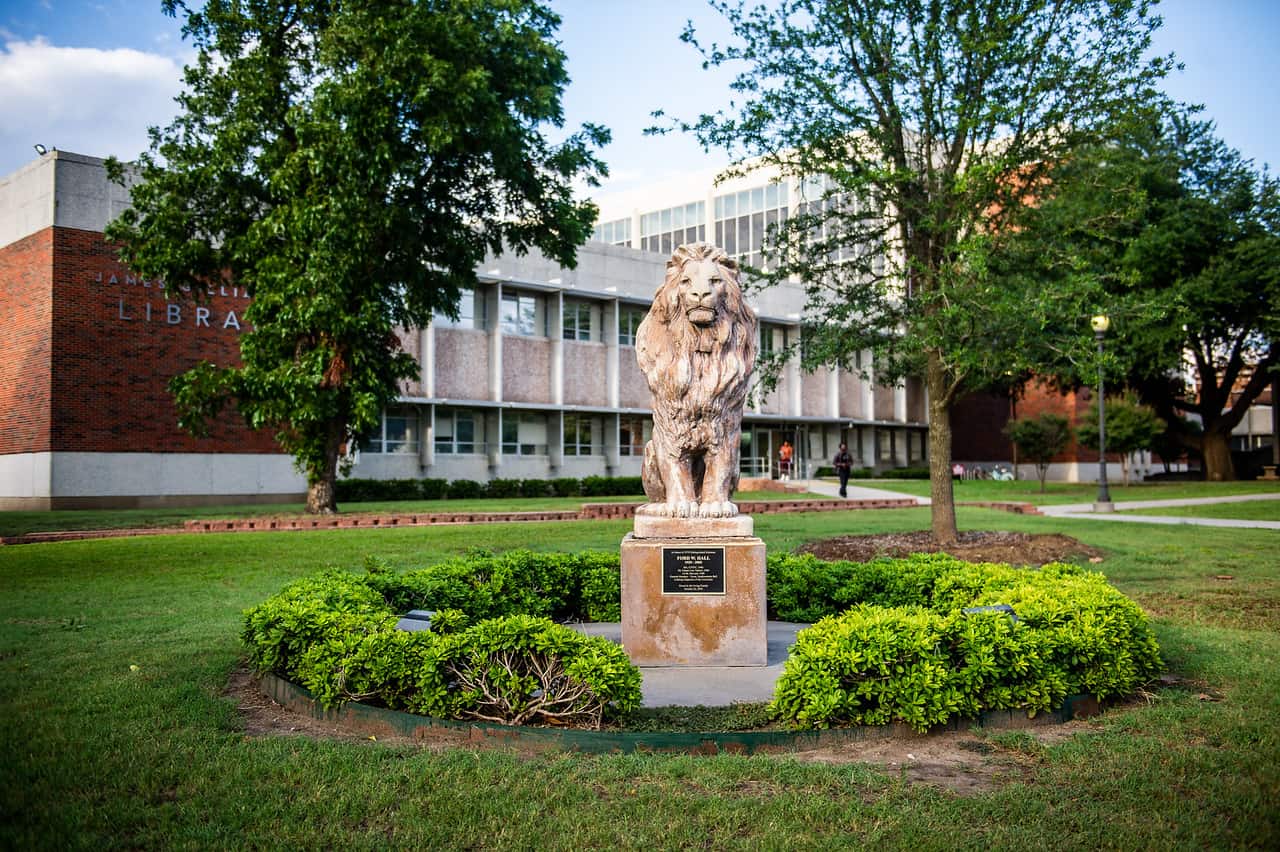
Student Achievement
2022 Achievements
As we continuously measure our success and evaluate our opportunities for improvement, we are moving forward to become the university of choice for everyone who is seeking higher education in the East Texas region and beyond. Explore our university's facts and stats to find out who we are and how we are doing!
Campus Facts
Quality
U.S. News and World Report's 2022 university rankings reveal that A&M-Commerce rises to the top among state and national universities. Among ranked schools, A&M-Commerce was named:
- Tied for 1st in Texas for Best Online Bachelor's in Business Programs
- 3rd in Texas for Best Online Bachelor's Program
- 5th in Texas for Best Online Master’s Business Program (Excluding MBA)
- 7th in Texas for Best Online Graduate Education Program
- 7th in Texas for Best Online Master’s in Criminal Justice Program
- 9th in Texas for Best Online MBA Program
- 13th in Texas for Best Education Schools
- 36th in the nation for Best Online Graduate Criminal Justice Program
- 49th in the nation for Best Online Bachelor’s Program
- 66th in the nation for Best Online Bachelor’s in Business Program
- 87th in the nation for Best Undergraduate Engineering Programs (where doctorate is not offered)
- 97th in the nation for Best Online Master’s in Education Program
- 105th in nearly 400 national schools for Top Performers on Social Mobility National Universities
- 110th in the nation for Best Online MBA Program
- 196th in the nation for Best Education Schools
Affordability
Data shows that A&M-Commerce is one of the region’s most affordable universities.
Tuition Per Year
TEXAS RESIDENT: $22,983
NON-RESIDENT: $35,433
Price Comparison per Year
Highlights
Low tuition cost
Affordable room and board
Great financial aid opportunities
Students graduate with lower debt amount and rate
Accessibility
To meet the needs of today’s busy students, A&M-Commerce offers classes in a variety of accessible formats, including:
- More than 12 100% online degree programs
- More than 55 hybrid/blended online degree programs
- Six off-site locations (see map below)
- Texas A&M University-Commerce at Dallas — Dallas, TX
- Mesquite Metroplex Center — Mesquite, TX
- Collin Higher Education Center — McKinney, TX
- Navarro Partnership — Corsicana, TX
- RELLIS Academic Alliance — Bryan, TX
Inclusivity
A&M-Commerce is committed to fostering a welcoming environment where all are respected. The following chart shows student enrollment by ethnicity in Fall 2022.

Highlights
- A&M-Commerce is a diverse and culturally inclusive campus, with increasing minority enrollment.
- A&M-Commerce provides excellent programs to attract students from a variety of backgrounds.
- A&M-Commerce ranked in the top 10% by U.S. News and World Report for best online bachelor’s program to attract diverse learners.
- A&M-Commerce features a fast-growing Hispanic student population.
In addition:
Male students represent 38% of the student body.
Female students represent 62% of the student body.
Employability
A&M-Commerce keeps its thumb on the pulse of industry needs to provide a relevant education that prepares students to compete for the best jobs on the market.
Undergraduate seniors report that A&M-Commerce has prepared them with good to excellent marketable skills.
% of A&M-Commerce graduating Seniors indicating good to excellent skill levels.
Highlight
Graduate Employment Rates: According to the A&M-Commerce 2019 Alumni Survey, 82% of undergraduates and 91% of graduate students were employed within 12 months of receiving their degrees.
Social Mobility
In a 2018 survey, A&M-Commerce alumni were asked to compare their current standard of living, after college, to their previous standard of living, at the time they started college. All A&M-Commerce alumni who responded indicated that their standard of living today exceeds that of their families. Students who have been out of college the longest reported the most upward social mobility (Class of 2013), followed by first-generation students and graduate students.
Highlights
- A&M-Commerce promotes social mobility by offering affordable tuition, admitting economically disadvantaged students and providing quality academic programs that prepare students to compete in the job market.
- A&M-Commerce is ranked 105th in the nation for Top Performers on Social Mobility National Universities and is one of only 28 Texas national universities ranked as a top performer on social mobility.
Overall Satisfaction
In the 2018 Ruffalo Noel-Levitz Student Satisfaction Inventory, students rated the following areas of the A&M-Commerce experience as both of high-importance and highly satisfactory:
- Ability to experience intellectual growth
- Commitment to academic excellence on campus
- University reputation within the community
- Faculty knowledge in their fields
- Variety of courses provided on campus
- Library resources and services
- Availability of tutoring services

Outcomes Measures for Student Achievement
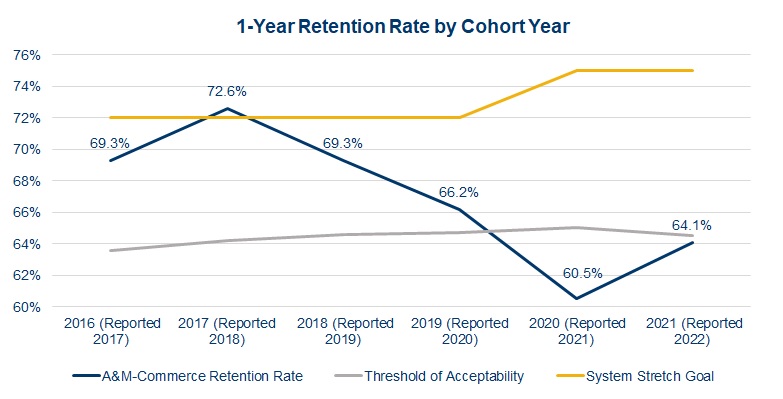
1-Year Retention Rate by Cohort Year
The percentage of first-time, full-time students seeking bachelor’s degrees who returned to A&M-Commerce for their second year (fall-to-fall retention).
Source: EmpowerU
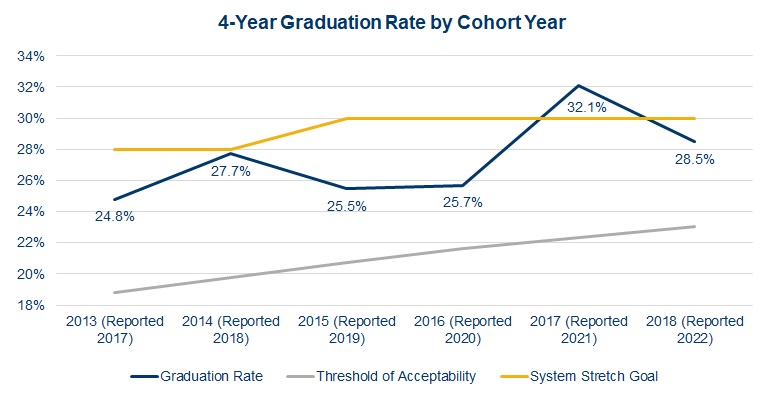
4-Year Graduation Rate by Cohort Year
The percentage of first-time, full-time students seeking bachelor's degrees who graduated from A&M-Commerce within 4 years.
Source: EmpowerU
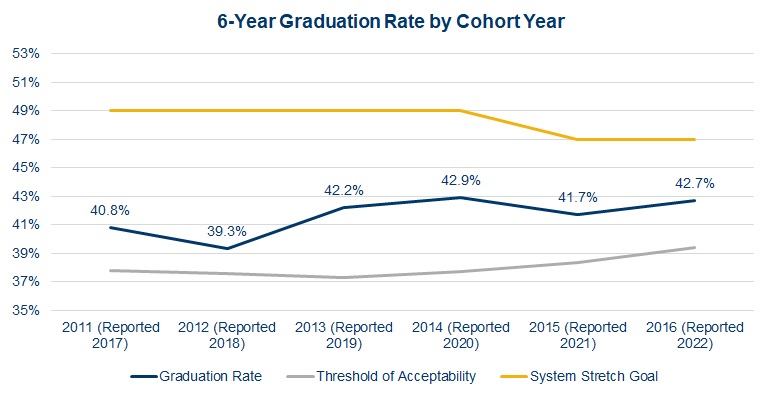
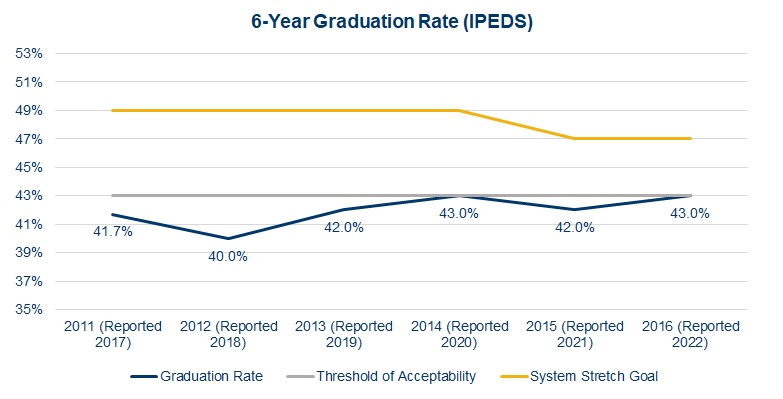
6-Year Graduation Rate by Cohort Year
The percentage of first-time, full-time students seeking bachelor's degrees who graduated from A&M-Commerce within six years.
Highlights:
- Students in the 2016 cohort graduated at a rate of 3.3 percentage points higher than the average for A&M-Commerce over the previous five years (as reported by EmpowerU).
- 43% of students in the 2016 cohort graduated within six years (as reported by IPEDS).
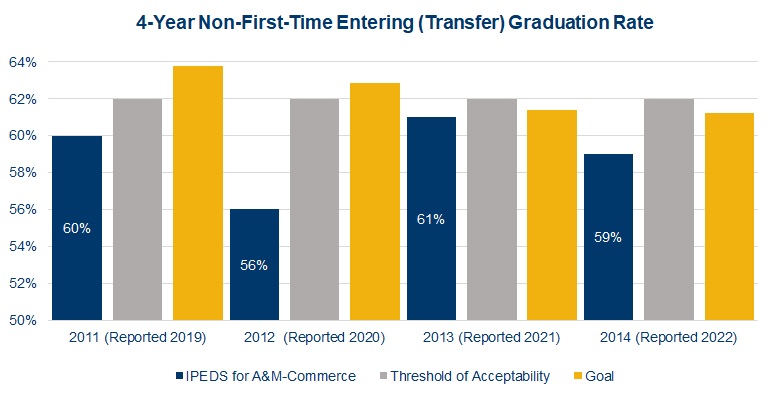
Transfer Graduation Rate
The percentage of full-time non-first-time-entering students by cohort year who pursued bachelor’s degrees and who graduated from A&M-Commerce within 4 years (as reported by IPEDS).
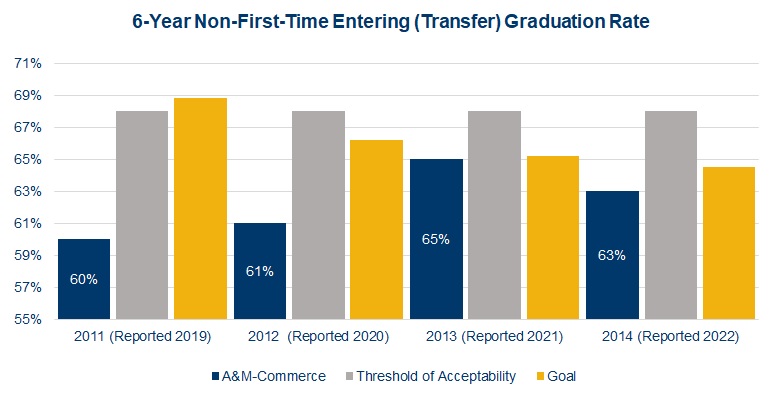
The percentage of full-time non-first-time-entering students by cohort year who pursued bachelor's degrees and who graduated from A&M-Commerce within 6 years (as reported by IPEDS).
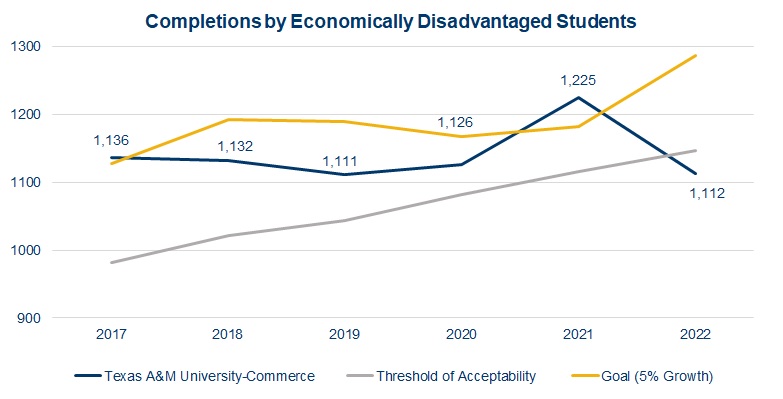
Completions by Economically Disadvantaged Students
The number of bachelor’s degrees awarded to economically disadvantaged students—those receiving Pell Grants at any time.
Highlights:
- From 2019 to 2021, there was a steady increase in the number of bachelor’s degrees awarded to economically disadvantaged students at A&M-Commerce.
- The number of bachelor’s degrees awarded to economically disadvantaged students in 2021 was 8.9% higher than the average for A&M-Commerce over the previous five years (as reported by the Texas Higher Education Accountability System).
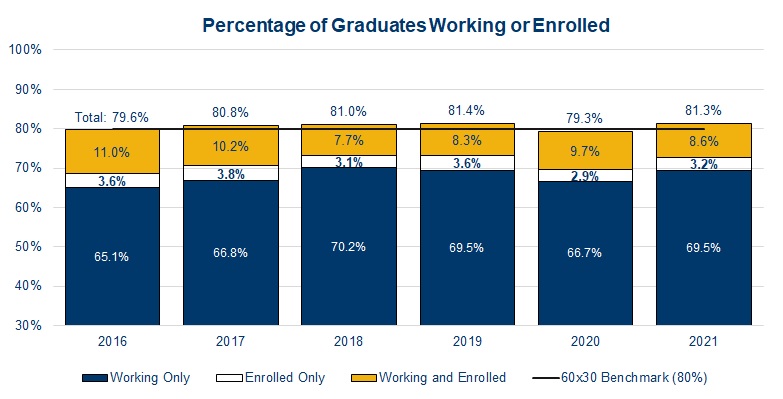
Percentage of Graduates Working or Enrolled
The percentage of students awarded a degree in a given year who are employed in the fourth quarter of the calendar year in which the program (fiscal year) ends or enrolled in a Texas public or private institution in the fall semester after receiving the award.
The Texas Higher Education Coordinating Board’s (THECB) 60x30TX strategic plan includes a goal that by 2030, 60% of Texans aged 25 to 34 will have either a certificate or degree (credential). Those credentials would impart “identifiable marketable skills” to graduates. The THECB tracks post-graduation outcomes within one year of the award of a credential. Institutions track students and report the percentage of those working, enrolled, or working and enrolled within a year of completion.
Highlight:
- In 2021, 81% of A&M-Commerce graduates were working within the state of Texas and/or enrolled in a Texas public or private college.
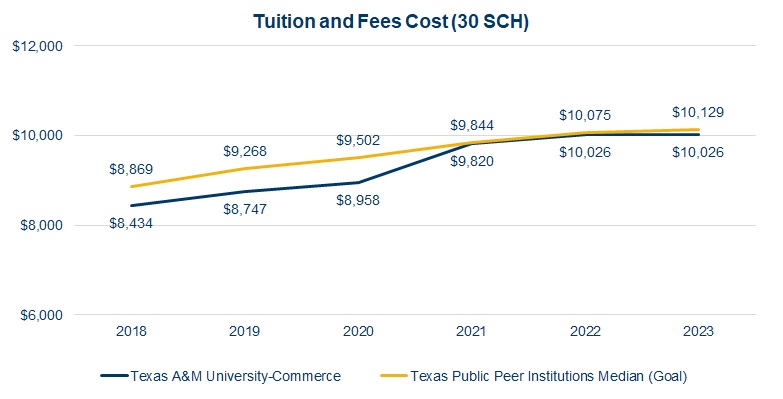
Tuition and Fees Cost (30 SCH)
The average cost of mandatory tuition and fees charged a student taking 30 semester credit hours.
A&M-Commerce is committed to remaining affordable and seeks to rein in student costs but also attend to the relative value of a student’s degree versus those costs. A&M-Commerce’s tuition and fees are significantly below the median tuition and fees for the university’s state public peer institutions, as defined by the THECB.



 Campus Facts
Campus Facts